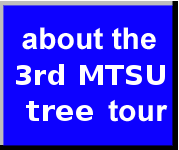
|

|

|

|
An individual instance of Fraxinus americana (white ash)
Permanent unique identifier for this particular organism:
http://bioimages.vanderbilt.edu/mtsu/3
Notes:
Description
General: Olive family (Oleaceae). Native trees growing to 20-30 m tall, maintaining a central leader (strong apical dominance) in youth with an even distribution of branches, developing a dense, conical or rounded crown at maturity. The trunk is long, straight, and free of branches for most of its length (except when open grown). The bark is thick, dark gray, with a uniform, diamond-shaped ridge and furrow pattern. Leaves are deciduous, opposite, pinnately compound, 20-38 cm long, leaflets usually 7(5-9), short-stalked, ovate to ovate-lanceolate or elliptic, acuminate, 6-13 cm long and 3-6 cm wide, sometimes with a few teeth near the tip, dark green and smooth above, whitish below. Flowers are numerous, very small, green to purplish, in small branched clusters near the branch tips, usually either male (staminate) or female (pistillate), a single tree usually bearing only one sex (the species dioecious). Fruits are samaras 2.5-5 cm long, hanging in clusters, with a narrow wing extending about 1/3-1/4 of the way down the cylindrical body. The common name is in reference to the white color of the wood.
This species flowers in April-May, the male first, before appearance of the leaves; fruiting August-October, the seeds dispersed September-November. The pollen is already airborne during the 7-10 days when the female flowers are receptive.
Uses
White ash is a good tree for open areas such as parks and campuses; it also is used as a lawn, shade, and street tree, even though its potential large size can make it incongruous with a small area. It is an erect, graceful tree, often with bronze-purple fall foliage. It is easy to transplant and has been used in re-vegetating disturbed sites.
The wood of white ash is valued for its strength, hardness, heavy weight, and elasticity (shock resistance). Native Americans appreciated its usefulness for tools and implements, and it is used extensively today for tool handles. Its use in wooden baseball bats is famous. The wood is also used in furniture, doors, veneer, antique vehicle parts, railroad cars and ties, canoe paddles, snowshoes, boats, posts, ties, and fuel. White ash is the most valuable timber tree of the various ashes.
White ash was used by Native Americans for a variety of medicinal purposes: a decoction of the leaves as a laxative and general tonic for women after childbirth; the seeds as an aphrodisiac, a diuretic, an appetite stimulant, a styptic, an emetic, and as a cure for fevers; and a bark tea for an itching scalp, lice, snakebite, and other sores. Juice from the leaves has been applied to mosquito bites for relief of swelling and itching.
White-tailed deer and cattle browse white ash and beaver, porcupine, and rabbits may eat the bark of young trees. The seeds are eaten by wood duck, northern bobwhite, turkey, grouse, finches, grosbeaks, cardinals, fox squirrel, mice, and many other birds and small mammals. The tendency of white ash to form trunk cavities makes it valuable for cavity nesters such as redheaded, red-bellied, and pileated woodpeckers. Once primary nest excavators have opened up the bole, it is an excellent habitat for secondary nesters such as wood ducks, owls, nuthatches, and gray squirrels.
Distribution
White ash grows over most of eastern North America, absent only from the outer Atlantic and Gulf coastal plains. It occurs from Nova Scotia west to eastern Minnesota and south to Texas and northern Florida, northward barely into southern Quebec and Ontario.
Establishment
Adaptation: White ash grows best on deep, well-drained, moist soils with other hardwoods at elevations of about 0-1050 meters. It rarely forms pure stands. It occurs on middle slopes in the Northeast, on slightly elevated ridges in the floodplains of major streams in the coastal plain, and on slopes along major streams in the central states. Primary associates are eastern white pine, northern red oak, white oak, sugar maple, red maple, yellow birch, American beech, black cherry, eastern hemlock, and yellow poplar.
White ash is primarily characteristic of early and intermediate stages of succession. White ash begins producing seed at a minimum age of 20 years. White ash resprouts from the root crown after logging or fire. Sprouting ability decreases with age.
Environmental Concerns
Ash decline (or ash dieback or ash yellows) is the most serious problem affecting white ash. The decline is especially prevalent in New York, Pennsylvania and Vermont but occurs from the Great Plains to the Atlantic coast at 39°-45° N latitude. Mycoplasma-like organisms (MLO, the cause of ash yellows) have been found associated with most of the dying trees. Not all dying trees are infected and ash decline is thought to result from multiple causes - MLO plus various fungi and viruses, as well as atmospheric pollution and drought. White ash is sensitive to ozone, sulfur dioxide, nitrous oxides, and associated acid deposition, which may cause the appearance of necrotic lesions on the leaves. Most of recent ash decline has occurred in areas with high levels of these gases.
References
USDA NRCS (2003). White ash plant guide. Retrieved from http://plants.usda.gov/java/factSheet

|

|
|
Load database and switch to thumbnail view
Use this stable URL to link to this page:
http://bioimages.vanderbilt.edu/mtsu/3.htm
This particular organism is believed to have managed means of establishment.
This organismal entity has the scope: multicellular organism.
Identifications:
Fraxinus americana
L.
sec. Tennessee Flora 2014
common name: white ash
family: Oleaceae
Identified 2016-03-13 by Patrick Phoebus
Location:
Old Main Circle, Rutherford County, Tennessee, US
Click on these geocoordinates to load a map showing the location: 35.8454°, -86.3698°
Coordinate uncertainty about: 10 m.
Altitude: 185 m.
Location calculated as average of its images' coordinates.
Occurrences were recorded for this particular organism on the following dates:
2016-03-13
2016-04-27
The following images document this particular organism.
Click on a thumbnail to view the image and its metadata. Load database and enable navigation by taxon and organism.
| Image | View |
|
|
whole tree (or vine) - general |
|
|
whole tree (or vine) - winter |
|
|
whole tree (or vine) - winter |
|
|
bark - unspecified |
|
|
leaf - showing orientation on twig |
|
|
leaf - showing orientation on twig |